Artículo
Permanent superhydrophobic polypropylene nanocomposite coatings by a simple one step dipping process
Fecha de publicación:
04/2014
Editorial:
Elsevier Science
Revista:
Applied Surface Science
ISSN:
0169-4332
Idioma:
Inglés
Tipo de recurso:
Artículo publicado
Clasificación temática:
Resumen
Superhydrophobic nanocomposite coatings on injection-molded polypropylene (PP) samples were prepared by dipping in xylene solvent containing titanium dioxide nanoparticles (NPs) functionalized with trimethoxypropyl silane. Alternatively, PP samples were dipped in a mixture of functionalized NPs and dissolved PP pellets. As a general result, dip-coated PP samples reached a permanent superhydrophobic state with a contact angle hysteresis (CAH) depending on NPs concentration and surface chemistry. SEM and profilometer measurements show a general trend in the decrease of CAH with the increase of aggregates and roughness. However some results showed that surfaces with the same roughness presented different CAHs. XPS measurements showed that low CAHs and self-cleaning properties were obtained only when the Ti?OH relative concentration on the surface was about 20%. At higher Ti?OH relative concentrations, the surface kept a superhydrophobic static state but lost its self-cleaning properties. This work highlights the fact that both control of the roughness together with chemical surface composition of polar groups have to be taken into account for a precise tuning on the superhydrophobic dynamic component of the surface.
Archivos asociados
Licencia
Identificadores
Colecciones
Articulos(IMBIV)
Articulos de INST.MULTIDISCIPL.DE BIOLOGIA VEGETAL (P)
Articulos de INST.MULTIDISCIPL.DE BIOLOGIA VEGETAL (P)
Citación
Contreras, Cintia Belén; Chagas, Gabriela; Strumia, Miriam Cristina; Weibel, Daniel E.; Permanent superhydrophobic polypropylene nanocomposite coatings by a simple one step dipping process; Elsevier Science; Applied Surface Science; 307; 4-2014; 234-240
Compartir
Altmétricas




